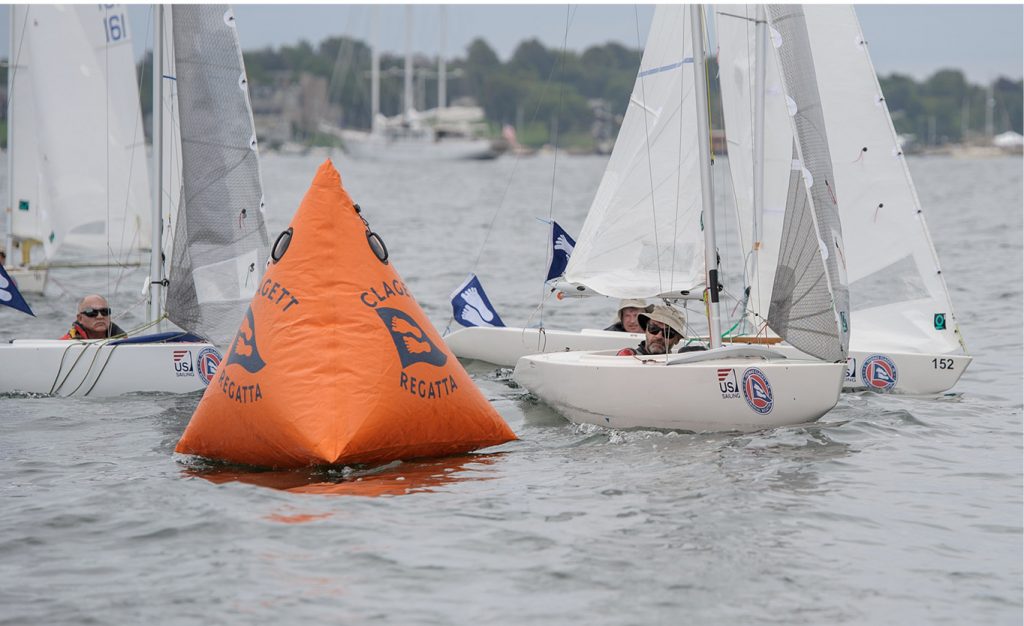When there are no other boats around, it’s easy to execute a good windward mark rounding. But unless you’re near the front (or back!) of the fleet, you normally have plenty of company as you approach the mark. And they’re all trying to beat you!
In order to implement your mark-rounding strategy (i.e. to have an optimal rounding), one thing you need is good tactics. Tactics are the boat-on-boat moves you make to follow your chosen course around the mark. The goal of boat-on-boat tactics is for you to stay in control of your race. The last thing you want, especially at a crowded spot like the windward mark, is to get pushed around by the actions of other boats.
Use these tactical moves to get ahead of nearby boats before you reach mark or to consolidate your position ahead of the boat(s) right behind you. Just remember that it’s difficult to be successful tactically unless you have good boatspeed, solid boathandling, knowledge of the rules, and a clear picture of what you’re trying to accomplish (strategy).
Lengthen the gap behind you. As you round the windward mark, it’s nice to have at least a couple boatlengths of space behind you, if possible. When you’re going onto a reach, this means you won’t have to deal with a boat sailing high right behind you. On a run, you won’t immediately be in the wind shadow of a boat astern.
To maximize the amount of space behind, there are a few tricks you can try before you reach the mark. One is to use your wind shadow to push nearby boats farther back.

Rounding the windward mark can be a challenge because there is usually so much happening. Keep your boat going fast, watch out for other boats, don’t break any rules, avoid overstanding (or under-standing) the mark, and don’t hit the mark. © Clagett Regatta/Ro Fernandez
Take a chance on a port-tack approach. It’s not usually a great idea to approach the windward mark on port tack (since you have to keep clear of other boats), but sometimes this is your best option. The problem with getting to the starboard-tack layline too early is that there’s usually a line of boats there. This means you would likely sail for a while in bad air, or you would have to overstand the mark a little. In either case, you’ll be slow or you’ll sail extra distance.
You could avoid the laylines as long as possible by staying in the middle of the course while approaching the mark. This will work some- times, but that area often has lots of bad air and choppy water, and is thus good to avoid. What this means is that a port-tack approach may be a good choice more frequently than you might think. If you’re close with several other boats as you approach the first mark, try going almost all the way to the port layline. This way you will keep your air clear while others are fighting for wind and position on the starboard layline.
As long as you can find a hole to tack into near the mark, the amount you gain will often be just enough to put you ahead of three or four nearby boats right at the mark.
“Close the door” on port tackers. When you’re approaching the mark on starboard tack, don’t let those boats approaching on port tack beat you around the mark. Though your position is strong under the racing rules, sometimes this is not enough to keep other boats from tacking in front of you, especially if they’re ahead of you or if you’ve overstood the mark.
Often the best way for you to take control in this situation is to bear off slightly so you “close the door” between you and the mark. By doing this, you make it difficult for any boat to tack between you and the mark without breaking a rule. Ideally, their only option will be to bear off and pass behind you. As soon as this happens, you can head up and round the mark. ■
This article originally appeared in David Dellenbaugh’s Speed & Smarts, The newsletter of how-to tips for racing sailors. If you want to sail faster and smarter, log onto SpeedandSmarts.com.



